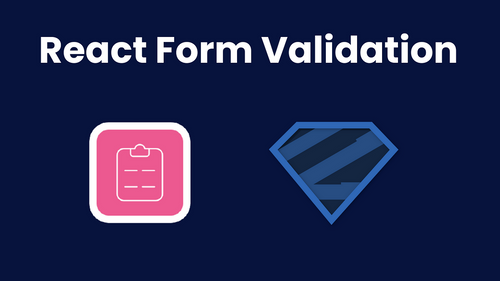In the world of React development, creating forms is a common task, and ensuring data accuracy is paramount. Email validation plays a crucial role in this process, as it prevents users from submitting incorrect or invalid email addresses. In this comprehensive guide, we will explore how to implement email validation using React Hook Form and Yup. We'll cover best practices, expert insights, and address common questions to help you become a proficient React developer.
The Significance of Email Validation in React Forms
Email validation is a vital aspect of form development for several reasons:
Data Accuracy: Valid email addresses are essential for maintaining accurate databases and communication.
Enhanced User Experience: Providing real-time feedback to users about their email input helps prevent errors and improves the overall user experience.
Security: Validating email addresses also contributes to the security of your application by preventing malicious input.
Email Validation with React Hook Form and Yup
React Hook Form and Yup are two powerful libraries that make form handling and validation in React applications easier. Let's dive into how to set up email validation using these tools.
1. Setting Up React Hook Form
To get started, you need to set up React Hook Form in your project. This library simplifies form management and allows you to define validation rules effortlessly.
2. Creating a Validation Schema with Yup
Yup is a JavaScript schema builder that enables you to create validation schemas declaratively. Define a schema that checks for valid email addresses using Yup's string() and email() methods.
3. Integrating React Hook Form with Yup
Integrate React Hook Form with Yup by using the useForm() and useFormContext() functions. This connection enables you to apply your Yup schema to your form fields effectively.
4. Adding Error Messages
Display error messages next to the email input field to provide feedback to users when they enter an invalid email address. React Hook Form and Yup make it easy to access error messages.
5. Styling Error States
Enhance the user experience by styling the email input field differently when it contains errors. This visual cue helps users quickly identify and correct their mistakes.
Best Practices for Effective Email Validation
To implement effective email validation in your React forms, consider these best practices:
Use Yup for Schema Validation: Yup simplifies the process of defining validation schemas and offers a wide range of validation methods.
Provide Clear Error Messages: Ensure that error messages are descriptive and easy to understand, helping users identify and correct issues.
Consider Async Validation: In some cases, email validation might require asynchronous checks, such as verifying if an email address already exists in your database.
Test Thoroughly: Always test your email validation with various email addresses to verify that it works as expected.
Common Challenges and How to Overcome Them
When implementing email validation in React forms, you may encounter challenges. Here's how to address some common issues:
1. False Positives
Striking the right balance between strict email validation and avoiding false positives can be challenging. Test your validation thoroughly to ensure it doesn't reject valid email addresses.
2. Internationalization
Account for international email addresses and non-ASCII characters in your validation schema. Yup supports Unicode characters for this purpose.
3. Testing
Implement automated testing to ensure your email validation continues to work as expected, even as your application evolves.
Expert Tips for Successful Email Validation
To excel in email validation with React Hook Form and Yup, consider these expert tips:
Pattern Variability: Email validation patterns can vary based on specific business requirements. Be prepared to adapt and modify your schemas.
Community Resources: Explore online forums and communities for guidance and insights from other React developers.
Cross-Check with Libraries: Validate email addresses using multiple methods, including libraries like Yup, to improve accuracy.
Regular Updates: Stay updated with changes in email standards and adjust your validation schemas accordingly.
Continuous Testing: Implement automated testing to ensure your validation remains effective as your application evolves.
Frequently Asked Questions (FAQs)
1. Can I use other validation libraries alongside Yup with React Hook Form?
Yes, you can combine Yup with other validation libraries, or you can choose to use only Yup for all your validation needs.
2. Are there any limitations to email validation with React Hook Form and Yup?
While these libraries are powerful, they are just tools. The effectiveness of email validation also depends on the quality of your validation schema.
3. Can I validate email addresses asynchronously, such as checking if they exist in a database?
Yes, you can perform asynchronous email validation by incorporating asynchronous Yup validation methods.
4. How do I handle international email addresses in my validation schema?
Yup supports Unicode characters, so you can include them in your validation patterns for international email addresses.
5. Should I perform both client-side and server-side email validation?
Yes, combining client-side validation
with server-side validation is recommended for enhanced security and accuracy.
Conclusion
Mastering email validation with React Hook Form and Yup is a valuable skill for any React developer. It ensures data accuracy, enhances the user experience, and contributes to the overall security of your applications. By following best practices, addressing common challenges, and staying updated with expert tips, you can become proficient in implementing robust email validation in your React forms.



